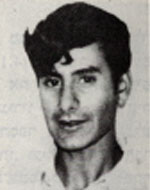Rihani, Yehezkel (Hezi)
Yehezkel, son of Juliet and Shaul, was born in Be’er Sheva on December 26, 1952. He completed his elementary studies at the Netaim School in Be’er Sheva and completed his high school studies at the ” He was a member of the Hashomer Hatzair youth movement and later became a member of the movement, and was very attached to the club and its members, and continued to visit the nest even after he had grown up and stopped his apprenticeship. As part of the movement, he liked to play sports and especially basketball, but devoted most of his time to his greatest love – to live, especially to snakes. He was interested in the theoretical aspects of animal life, and he read many books about animals, raising and preserving animals, because of his hobby, he used to take long walks in nature, and was interested mainly in the surrounding environment and its various locations. After two years he stopped studying and began working at the Institute for the Study of the Negev, where he hoped to study in various fields, theoretical and practical, related to his favorite subject. At the beginning of his career he worked in the field of plant research, but since the plant was less interested in the plant than the animal, he went to work at the university animal house. In this framework, he worked for two years in the treatment of various animals with Dr. Hermann Ziner, from whom he learned a great deal, and during the course of his work he often went on patrols, both day and night, observing the animals and learning their character, behavior and lifestyle. He was drafted into the IDF at the beginning of November 1971 and was assigned to the Golani infantry brigade, where he completed his matriculation exams in order to continue studying in areas of interest to him. After basic training, and after completing his training course for saboteurs, he was placed as a sapper and part of his military service as part of the Golani reconnaissance unit. During the Yom Kippur War, Hezi participated in battles against the Syrians in the Golan Heights. During the battle that took place on Mount Hermon on October 22, 1973, he was hit by enemy fire and killed. He was laid to rest in the military cemetery in Be’er Sheva. Survived by his parents, sisters and brother. After his fall, he was promoted to corporal.
